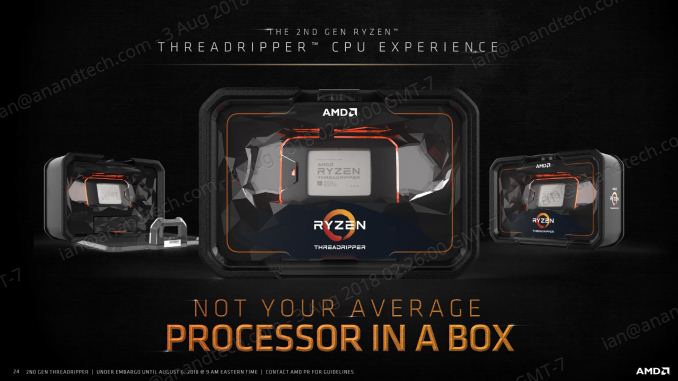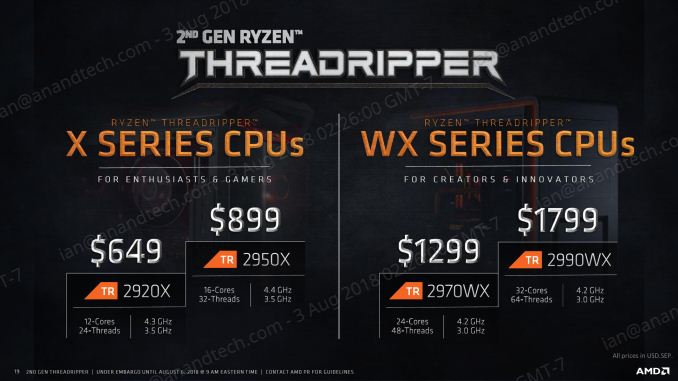The AMD Threadripper 2 Teaser: Pre-Orders Start Today, Up to 32 Cores
by Ian Cutress on August 6, 2018 9:00 AM EST_678x452.jpg)
The biggest news to come out of Computex, AMD’s second generation of its Ryzen Threadripper platform, is almost here. Today’s announcement is all amount images, speeds and feeds, specifications, and an ‘unboxing’ announcement, leading to pre-orders a week before retail. As much as it pains me that there is an unboxing embargo and pre-orders before we even know how the new chips will perform, here we are. Today we get to go through the on-box specifications, discuss the design, and show what AMD included in our press kit.
2990WX Pre-Orders Open Today, Retail August 13th
The formal launch of the new parts is one week from today, and in the biggest markets the first processor of the launch should be available for pre-order. AMD is set to launch four versions of its second generation Ryzen Threadripper over the course of Q3, starting with its flagship 32-core.
| AMD SKUs | |||||||
| Cores/ Threads |
Base/ Turbo |
L3 | DRAM 1DPC |
PCIe | TDP | SRP | |
| TR 2990WX | 32/64 | 3.0/4.2 | 64 MB | 4x2933 | 60 | 250 W | $1799 |
| TR 2970WX | 24/48 | 3.0/4.2 | 64 MB | 4x2933 | 60 | 250 W | $1299 |
| TR 2950X | 16/32 | 3.5/4.4 | 32 MB | 4x2933 | 60 | 180 W | $899 |
| TR 2920X | 12/24 | 3.5/4.3 | 32 MB | 4x2933 | 60 | 180 W | $649 |
| Ryzen 7 2700X | 8/16 | 3.7/4.3 | 16 MB | 2x2933 | 16 | 105 W | $329 |
Sitting at the top of the stack is the 32-core 2990WX, which will retail at $1800, competing directly against Intel’s existing 18-core part, the Core i9-7980XE. AMD is using "WX" in the name here to offer some branding consistency with their high-end workstation graphics models, the Radeon Pro WX series.
Beating at its heart are four 12nm "Zen+" Zeppelin dies, each with eight cores, connected by AMD’s Infinity Fabric, and using simultaneous multi-threading for a total of 64 threads. As with previous generations, there are 60 PCIe 3.0 lanes for add-in cards and storage, and another four lanes for the chipset. There is a slight change in the memory speed, with the new parts supporting DDR4-2933.
Joining the WX line is the Ryzen Threadripper 2970WX, set at $1299 MSRP. This 24-core part uses three cores per CCX (so six cores per die, four dies per package), and also has simultaneous multi-threading for a total of 48 threads. Speeds are equal to the TR 2990WX, with a 3.0 GHz base clock and a 4.2 GHz single core turbo. Per-core turbo speeds will be decided by Precision Boost 2 and XFR2, as explained below. The 2970WX is set for an October launch.
Both of the WX models are hitting the new TDP of 250W, although the way AMD measures TDP is heavily dependent on the cooler used. In this case, their new high-end ‘Wraith Ripper’ cooler is the benchmark, which is developed by Cooler Master. This new cooler is very large, but offers full heatspreader coverage – which as we've discovered is critical for Threadripper cooling – and provides good clearance for memory. It will be sold separately in the channel, at around $100 MSRP.
Also on the table are the 2950X ($899) and the 2920X ($649), which use the existing X branding. This is because these processors are direct replacements for the 1950X and 1920X, using only two active dies in each chip, but this time around are using Zen+, the second generation Ryzen features such as faster caches and better frequency characteristics. The 16-core TR 2950X will have a base frequency of 3.5 GHz, a turbo of 4.4 GHz, and is due to launch on August 31st. The 12-core TR 2920X by comparison also has a 3.5 GHz base frequency, but a slightly lower turbo at 4.3 GHz, and is due out in October. Both of these parts are set at 180W TDP, like the first generation chips.
| AMD Ryzen Product Stacks & Launch Prices | |||
| Ryzen 1000 (2017) | Ryzen 2000 (2018) | ||
| - | TR 2990WX (32C) | $1799 | |
| - | TR 2970WX (24C) | $1299 | |
| TR 1950X (16C) | $999 | TR 2950X (16C) | $899 |
| TR 1920X (12C) | $749 | TR 2920X (12C) | $649 |
| TR 1900X (8C) | $599 | - | |
| Ryzen 7 1800X (8C) | $499 | Ryzen 7 2700X (8C) | $329 |
| Ryzen 7 1700X (8C) | $399 | ||
At this point AMD has not stated if it will expand the family even further, so we don't know if the 1900X will stay at the bottom of the stack, be replaced with a 2000 series model, or if it dies off completely.
At this point, AMD’s main competition is still with Intel’s Skylake-X parts. The 32-core 2990 WX will align in price with the 18-core Core i9-7980XE.
| Threadripper 2 vs Skylake-X The Battle (Sorted by Price) |
||||||||
| Cores/ Threads |
Base/ Turbo |
L3 | DRAM 1DPC |
PCIe | TDP | SRP | ||
| Intel | i9-7980XE | 18/36 | 2.6/4.4 | 24.75 | 4x2666 | 44 | 140W | $1999 |
| AMD | TR 2990WX | 32/64 | 3.0/4.2 | 64 MB | 4x2933 | 60 | 250W | $1799 |
| Intel | i9-7960X | 16/32 | 2.8/4.4 | 22.00 | 4x2666 | 44 | 140W | $1699 |
| Intel | i9-7940X | 14/28 | 3.1/4.4 | 19.25 | 4x2666 | 44 | 140W | $1399 |
| AMD | TR 2970WX | 24/48 | 3.0/4.2 | 64 MB | 4x2933 | 60 | 250W | $1299 |
| Intel | i9-7920X | 12/24 | 2.9/4.4 | 16.50 | 4x2666 | 44 | 140W | $1199 |
| Intel | i9-7900X | 10/20 | 3.3/4.3 | 13.75 | 4x2666 | 44 | 140W | $980 |
| AMD | TR 2950X | 16/32 | 3.5/4.4 | 32 MB | 4x2933 | 60 | 180W | $899 |
| AMD | TR 2920X | 12/24 | 3.5/4.3 | 32 MB | 4x2933 | 60 | 180W | $649 |
| Intel | i7-7820X | 8/16 | 3.6/4.3 | 11 MB | 4x2666 | 28 | 140W | $593 |
| AMD | TR 1900X | 8/16 | 3.8/4.0 | 16 MB | 4x2666 | 60 | 180W | $549 |
| AMD | R7 2700X | 8/16 | 3.7/4.3 | 16 MB | 2x2933 | 16 | 105W | $329 |
Across the metrics, AMD has more cores, is competitive on frequency, has more memory channels, more PCIe lanes, and supports higher memory clockspeeds. Intel has lower power, and above 16 cores a slight turbo clockspeed advantage. Meanwhile we already know from Ryzen 2000-series testing that cache speeds are a back-and-forth competition, and Intel has a slight IPC advantage. Game on.












101 Comments
View All Comments
blppt - Monday, August 6, 2018 - link
R15 is very well multithreaded, not the ideal indicator of real-world performance, so would we really expect an 8700K to dominate a 2600X in an ideal multithreaded benchmark?mapesdhs - Monday, August 6, 2018 - link
Cinebench as a benchmark may be reaching EOL, unless they update it again somehow. See:https://linustechtips.com/main/topic/815405-cinebe...
A better test in some ways would be c-ray, as LTT mentions, since it can scale to hundreds of threads no problem.
Ian.
eastcoast_pete - Monday, August 6, 2018 - link
Yes, every company puts their best foot/benchmark forward. The 7920/40/60 (all x) chips from Intel will still have a serious advantage in any application that can really utilize AVX 512, as that provides a huge performance boost. Unfortunately (for Intel), using AVX 512 also makes their chips run really, really hot (might be time for Intel to invest in some better thermal solutions for their pricey chips). Ultimately, it still boils down to: What are using your workstation for?virpuain@gmail.com - Monday, August 6, 2018 - link
Like winrar ??? lelDug - Thursday, August 9, 2018 - link
Yes! All day long, every day. :) I can't stop using it! Have to compress everything!Midwayman - Monday, August 6, 2018 - link
I have no legitimate use for 32 cores, but Hrrrrrgggghhhhhh. Fully torqued for that many cores.HStewart - Monday, August 6, 2018 - link
I would rather have fewer stronger cores than more weaker cores.The Hardcard - Monday, August 6, 2018 - link
Even if it was barely more than half the cores that are less than 15 percent stronger? Come on, even your 35-year-old scalar, nonpipelined processor with no branch prediction will quickly tell you that you will be far behind on nearly every workstation task.Make a list of the top 15 reasons people who actually do work and could use a high-end workstation to take care of business. Now question: will the Core i9-7980XE be faster atany single one?
DigitalFreak - Monday, August 6, 2018 - link
People here, and on most tech sites for that matter, keep thinking of these processors in terms of gaming. That's obviously not what they're designed for.drajitshnew - Monday, August 6, 2018 - link
@digitalfreak It is quite correct & true. Even three 1st gen threadripper was not marketed for pure gaming-- more towards content creaters and those who want to stream games professionally.On an other note I have reduced going to the sister site "Tom's " because Anandtech has a less FPS centric editorial outlook.